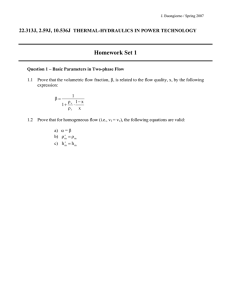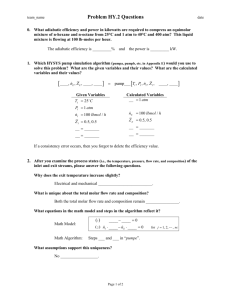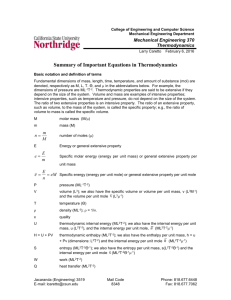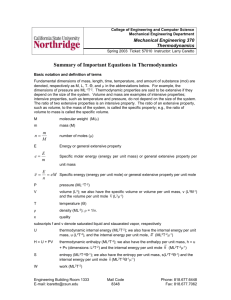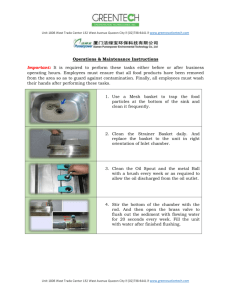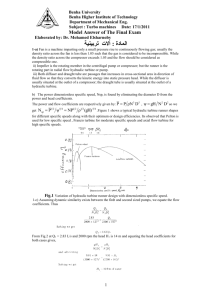Unit 5: March 6 - College of Engineering and Computer Science
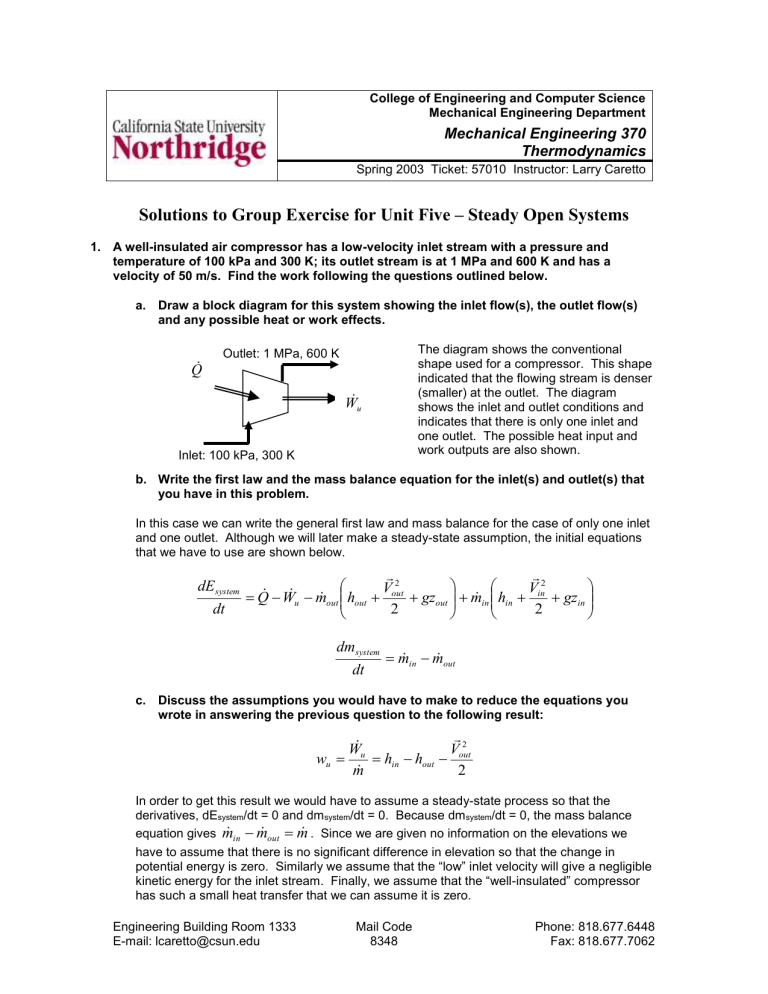
College of Engineering and Computer Science
Mechanical Engineering Department
Mechanical Engineering 370
Thermodynamics
Spring 2003 Ticket: 57010 Instructor: Larry Caretto
Solutions to Group Exercise for Unit Five – Steady Open Systems
1. A well-insulated air compressor has a low-velocity inlet stream with a pressure and temperature of 100 kPa and 300 K; its outlet stream is at 1 MPa and 600 K and has a velocity of 50 m/s. Find the work following the questions outlined below.
a. Draw a block diagram for this system showing the inlet flow(s), the outlet flow(s) and any possible heat or work effects.
Outlet: 1 MPa, 600 K
u
The diagram shows the conventional shape used for a compressor. This shape indicated that the flowing stream is denser
(smaller) at the outlet. The diagram shows the inlet and outlet conditions and indicates that there is only one inlet and one outlet. The possible heat input and work outputs are also shown.
Inlet: 100 kPa, 300 K b. Write the first law and the mass balance equation for the inlet(s) and outlet(s) that you have in this problem.
In this case we can write the general first law and mass balance for the case of only one inlet and one outlet. Although we will later make a steady-state assumption, the initial equations that we have to use are shown below. dE system dt
u
out
h out
V 2 out
2
gz out
in
h in
V in
2
2
gz in
dm system dt
in
out c. Discuss the assumptions you would have to make to reduce the equations you wrote in answering the previous question to the following result: w u
u
h in
h out
2
V out
2
In order to get this result we would have to assume a steady-state process so that the derivatives, dE system
/dt = 0 and dm system
/dt = 0. Because dm system
/dt = 0, the mass balance equation gives
in
out
. Since we are given no information on the elevations we have to assume that there is no significant difference in elevation so that the change in potential energy is zero. Similarly we assume that the “low” inlet velocity will give a negligible kinetic en ergy for the inlet stream. Finally, we assume that the “well-insulated” compressor has such a small heat transfer that we can assume it is zero.
Engineering Building Room 1333
E-mail: lcaretto@csun.edu
Mail Code
8348
Phone: 818.677.6448
Fax: 818.677.7062
Course Outline ME370, L. S. Caretto, Spring 2003 Page 2 d. Pick an appropriate set of property relations and find the work.
We can assume that air is an ideal gas at these temperatures and pressures. (Note that the exit pressure is a high pressure, but the temperatures are also high compared to the critical temperature.) Because of the large temperature difference we can use the ideal gas tables for air to account for the temperature dependence of the heat capacity. From Table A-17 on page 849 we find h in
= h(300 K) = 300.19 kJ/kg and h out
= h(600K) = 607.02 kJ/kg. Thus, the power per unit mass flow rate can be found as follows. w u
h in
h out
V
2 out
2
300 .
19 kJ kg
607 .
02 kJ kg
1
2
50 s m
2 kJ
s
2
1000 m
2
308 .
1 kJ kg
The negative value for the power per unit mass indicates that this is a work input device.
Note that consideration of the kinetic energy made a difference of only 1.25 kJ/kg or about
0.4%.
2. An adiabatic vessel has an inlet flow of steam at 3.5 MPa and 400 C and a second inlet stream of liquid water at 10 MPa and 40 C. The two streams mix and exit as a single stream which is saturated vapor at 9 MPa. a. Draw a block diagram for this system showing the inlet flow(s), the outlet flow(s) and any possible heat or work effects.
In this problem we have two inlet streams
(numbered one and two) and one outlet stream, (number three). Although we have shown arrows to indicate the heat input and work output we are given that the system is adiabatic so that the heat input is zero. Also there is no evidence of any useful work, so we assume that the work is zero.
2: Inlet: 3.5
MPa, 400 o
= 0
C
3: Outlet: 9 MPa, sat vap
u
= 0
1: Inlet: 10 MPa, 40 o C b. Make appropriate assumptions about the kinetic and potential energies, and the useful work. Explain why this is a steady-state problem. Write the first law and mass-balance equations for this problem.
We have no data with which to compute changes in kinetic and potential energies so we will assume that these are zero. Further, we will assume that the process is steady-state. As noted above, we are told that the process is adiabatic so that the heat transfer is zero.
Furthermore, we see no information about mechanical or electrical work transfers so we will say that the useful work is zero. This is a steady-state problem because the flow rates and the states of the inlet and outlet points are not changing with time. Thus, the total energy in the system and the total mass in the system are constant.
For these assumptions, the first law and the mass balance equations can be written as follows.
1 h
1
2 h
2
3 h
3
0
1
2
3
0
Course Outline ME370, L. S. Caretto, Spring 2003 Page 3 c. Divide the mass balance and first law equations by the mass flow rate of steam to
liquid get two simultaneous equations which contain mass flow rate ratio
steam for the two inlet streams.
For this problem the liquid water inlet is in stream number 1 and the steam inlet is in stream number two. In terms of these numbered streams, the problem asks for the computation of the ratio,
1 . If we divide both equations above by
2
, we get the following result.
2
1
2 h
1
h
2
3
2 h
3
0
1
2
1
3
2
0 d. Pick appropriate property relations and solve the mass balance and first law
liquid equations simultaneously to get the mass flow rate ratio . steam
Since we have water in both the liquid and vapor state, we must use the property tables for water. Because we know all three states, we can find the three enthalpy values. Thus, we have two equations in two unknown mass flow rate ratios. We can solve the mass balance equation for the ratio we do not want,
3 , and substitute this result into the energy
2 equation. When we do this we obtain a single equation for the desired mass flow rate ratio,
1
2
.
1
2 h
1
h
2
1
1
2
h
3
0
1
2
h
3 h
1
h
2 h
3
Using the tables for properties of water we find the required enthalpies as follows: h
1
= h(10 MPa, 40 o C) = 176.38 kJ/kg from Table A-7 for compressed liquid on page 838. Since state 3 is a saturated vapor, h
3
= h g
(9 MPa) = 2742.1 kJ/kg from Table A-5 on page 833; h
2
= h(3.5 MPa, 400 C) = 3222.3 kJ/kg from Table A-6 on page 835. Substituting these enthalpies into our equation for the flow rate ratio gives the desired answer.
1
2
h
3 h
1
h
2
h
3
2742 .
1 kJ kg
3222 .
3 kJ kg
176 .
38 kJ kg
2742 .
1 kJ kg
= 0.187

